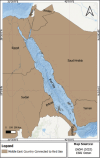Fish diversity assessment through conventional morphological identification and recent advances in Saudi Arabia: A review
- PMID: 39619925
- PMCID: PMC11606295
- DOI: 10.14202/vetworld.2024.2267-2285
Fish diversity assessment through conventional morphological identification and recent advances in Saudi Arabia: A review
Abstract
Fish identification in the Red Sea, particularly in Saudi Arabia, has a long history. Because of the vast fish diversity in Saudi Arabia, proper species identification is required. Indeed, identifying fish species is critical for biodiversity conservation, food and drug safety, and sustainable fishery management. Numerous approaches have been used to identify fish species, including conventional morphological identification, next-generation sequencing (NGS), nanopore sequencing, DNA barcoding, and environmental DNA analysis. In this review, we collected as much scientific information as possible on species identification in Saudi Arabia. Our findings suggest that the identification process has advanced and spread rapidly and broadly, as evidenced by the discovery of new fish species in Saudi Arabia. The advantages and disadvantages of each method were discussed as part of a comprehensive comparison. This study aimed to provide further scientific knowledge to promote the growth of fish diversity worldwide.
Keywords: Saudi Arabia; fish diversity; identification process.
Copyright: © Santanumurti, et al.
Conflict of interest statement
The authors declare that they have no competing interests.
Figures





References
-
- Sonnewald M, El-Sherbiny M.M. Red sea biodiversity. Mar. Biodivers. 2017;47:991–993.
-
- DiBattista J.D, Roberts M.B, Bouwmeester J, Bowen B.W, Coker D.J, Lozano?Cortés D.F, Choat J.H, Gaither M.R, Hobbs J.P.A, Khalil M.T, …&Berumen M.L. A review of contemporary patterns of endemism for shallow water reef fauna in the Red Sea. J. Biogeogr. 2016;43(3):423–439.
-
- Gajdzik L, Green A.L, Cochran J.E, Hardenstine R.S, Tanabe L.K, Berumen M.L. Using species connectivity to achieve coordinated large-scale marine conservation efforts in the Red Sea. Mar. Pollut. Bull. 2021;166:112244. - PubMed
-
- Young B.C, Shaikhi A.A. Sustainability estimates of coastline fish hatcheries in Saudi Arabia. N. Am. J. Aquac. 2022;84(4):442–446.
-
- Al Solami L. Status analysis of the Red Sea fisheries in the Kingdom of Saudi Arabia. Egypt. J. Aquat. Res. 2020;24(7):825–833.
Publication types
LinkOut - more resources
Full Text Sources
